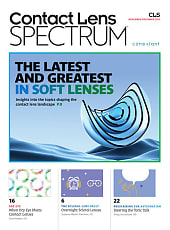feature
Work It!
You
can achieve visionary success with workstation eyewear, helping your patients
see well, attain visual comfort, and maintain workplace productivity
By Karlen McLean, ABOC, NCLC

While ECPs can't change their patient's workstation environment, they can make suggestions about how to best use it and they can change how patients see by prescribing workstation eyewear.
In addition to increasing practice revenue, promoting an expertise
in the workstation category can increase patient retention and recommendations,
and enhance short and long-term growth. The best way to do this is by building expertise
with Near Variable Focus (NVF) lenses.

NEAR VARIABLE FOCUS LENSES
Lenses specifically designed for computer and office use, known as near variable focus (NVF), occupational, office, computer, or workstation lenses, are valuable for solving visual challenges in an office setting.

Your goal is to provide NVF lenses so patients see well in three areas:
1. Past the computer screen to around the room—top of the
lens.

2. The computer screen—center of the lens.
3. Printed materials on a desk or viewing a keyboard—lens bottom.
FITTING TIPS
To fit NVF lenses properly requires thinking and acting outside the standard PAL, bifocal, or trifocal box. Tips honed for NVF lenses are:

B aware. NVF lenses require a specific B measurement in
order to take full advantage of the lens design. Generally,
B measurements should
be at least 30mm.
Hip to height. Typical minimum recommended fitting heights in NVF lenses are around 15mm.
PD gets around. Some NFV lenses require the near pupillary distance, while others require the distance PD. The prescription should include both. Take monocular PDs with a pupilometer, not a PD ruler.
| You Have the Power |
|
Manufacturers specify NVF lens power change as power shift, dynamic power, or degression rather than using the word "add." These terms describe the decrease in power from the total near power (TNP) in the reading area up to the top of the lens. For example, if the TNP is +2.00D, and the power shift is +1.25D, the top portion of the lens is +0.75D.
Some lens designs have one power shift, while others have two, three, or four. Check with manufacturers for complete details. NVF lenses need to be verified for the TNP or the amount of power present in the reading area of the lens. Verifying NVF anywhere but in the near power is inaccurate due to full aspheric design. The first priority in a NVF lens is to provide the widest clear intermediate area, then reading area, and finally distance vision. |
Fitting room. Pre-fit frames prior to taking lens measurements.
Place pantoscopic angle at 7 to 12 degrees, vertex distance
at 10mm to 12mm,
and ensure comfortable face form (curvature).
Talk power. Schedule regular touch-base conversations or meetings with your NFV lens provider of choice and your laboratory for updates. Get literature and tools, and look into specific NVF lens education programs to stay fresh.
OTHER OPTIONS
Remember that a workstation may be outside a typical office setting, like an airplane parts assembly line, a trailer on a construction job site, or a landscaper's greenhouse.
Recommend high-impact safety lenses and frames for patients who'll be wearing their workstation eyewear in heavy-duty work situations.
|
Other Options |
|
A
few patients may not be candidates for NVF lenses due to personal preference, visual
conditions, or adaptation factors. Here are some alternative workstation solutions: n Single-vision lenses that are measured, prescribed, and fit for a specific distance. n D-35 bifocals prescribed for intermediate vision in the top and near vision in the segment, with the near vision seg measured slightly lower for intermediate length viewing. n 7x35 or 8x35 trifocals offer wide intermediate and near vision segments and can be custom measured with the segs higher for primary intermediate and near viewing, with a smaller area for distance viewing. n Trifocals in 8x34, 10x35, or 12x35 offer 60 to 70 percent usage in the intermediate viewing area. n Progressive addition lenses (PALs) with a wider intermediate corridor and some designed for smaller frames may be good everyday choices, but may not offer comfortable long-term daily workstation use. Detail every patient's exact work style needs before automatically prescribing and fitting a standard PAL. |



